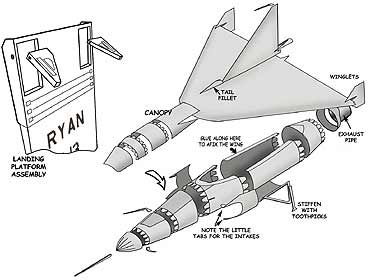



Ryan X-13 Vertijet (VTOL)
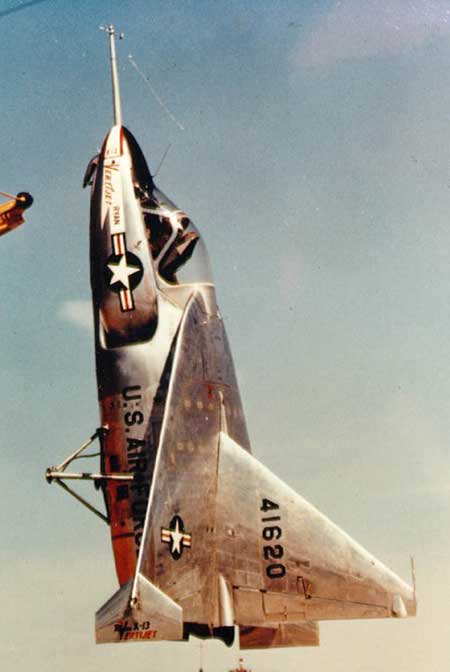
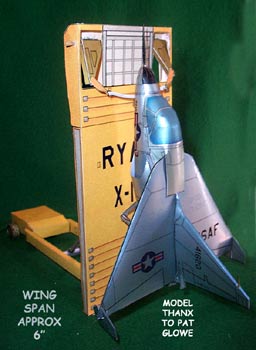
The Ryan X-13 Vertijet was designed to test the idea of vertical takeoff, transition to horizontal flight, and return to vertical flight for landing by jet aircraft. Equipped with a temporary tricycle landing gear.
It was flown conventionally on December 10, 1955 to test its overall aerodynamic characteristics. It was then fitted with a temporary "tail sitting" rig and on May 28, 1956, flown from the ground in a vertical position to test its hovering qualities.
The airplane made history on April 11, 1957, when it completed its first full-cycle flight at Edwards AFB, California. It took off vertically from its mobile trailer, rose into the air, nosed over into a level attitude, and flew for several minutes.
It then reversed the procedure to vertical flight and slowly descended to its trailer for a safe landing.
The ryan is hanging on the wall at the Air and Space Museum in San Diego. interestingly most of the instruments are missing, They were pulled when it was decommissioned because the instruments were considered TOP secret. They had to be mostly attitude and movement gauges that worked vertically and horizontally. but now no one knows what happened to them so the dashboard is mostly holes. other then that the thing is almost complete and ready to fly again. It took off and landed from a truck trailer that flipped vertically The trailer is in the museum too. Matt Sparks
Top Secret footage: I am impressed. Excellent cinematography! Breathtaking sets! A storyline that keeps you one the edge of you seat right up to the exciting conclusion! And best of all (Be still my heart!): Airplane noises from the Great One . . . Himself! Anne is an cinematic genius of the first order. I laughed so hard that I hurt myself. Great job all round. Thanks again. ymp, John
You're havin' way too much fun...I'm still giggling...Z
I know what it is its a back up alarm you know so the pilot wont run into the trash cans hahahahahahahha ...ethan
PSSST, chip. i just got a look at the vertijet secret clip. i sure hope you guys don't get into any trouble for releasing it. it sure looks good. your modeling pal dennis.......p.s. my wife thinks you have toooo much time on your hands, but i loved it
I just took a look at your "Secret FG Exclusive Footage" of the Ryan Vertijet, I was very interested in knowing what you guys were on, and do you have any left??...Anthony S.
Chip: I just watched the "Top Secret" video of the Ryan. I think you've been sniffin' to much Tacky Glue. You need a little more fresh air. Ed
Now show the pilot and crew back at the OC knockin' back a few to massage the old throat after the 'flight! What a hoot! You're as young as you wanna be, eh Chip? Thanks for that! Tim G
...obviously gonna be nominated for best special effects & Best Sound ....and of course best performance by leading Lady... Matt S
Chip, Still laughing. Did not realize that you were a test pilot! Was that the first flight? Cam
Are you sure that the Exclusive FG Footage is not violating the freedome of information act.. I think the pentagon would frown at releasing such "top secret" and "valuable" information!...still laughing...Dave
Chip has out done himself on this one! You really should check out his information page, and then try the links to the video clips ...amazing!! Well done, Chip! Jim Krauzlis
Actually I think the tag with the dog barking at the end made the piece. RM
Ryan Vertijet X-13
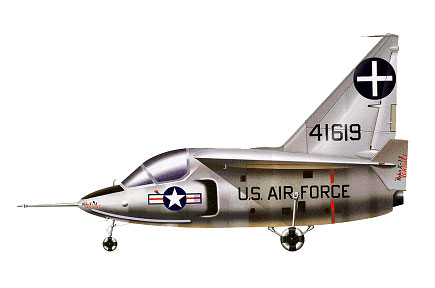
Video of our Vertijet in action (Must See!)
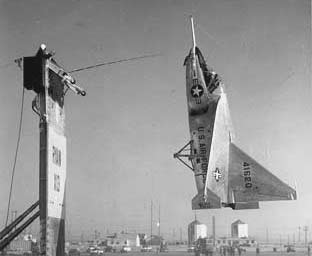 The X-13 was designed to test the idea of vertical takeoff, transition
to horizontal flight, and return to vertical flight for landing by
jet aircraft. Equipped with a temporary tricycle landing gear.
The X-13 was designed to test the idea of vertical takeoff, transition
to horizontal flight, and return to vertical flight for landing by
jet aircraft. Equipped with a temporary tricycle landing gear.
It was flown conventionally on December 10, 1955 to test its overall aerodynamic characteristics. It was then fitted with a temporary "tail sitting" rig and on May 28, 1956, flown from the ground in a vertical position to test its hovering qualities.
The airplane made history on April 11, 1957, when it completed its first full-cycle flight at Edwards AFB, California. It took off vertically from its mobile trailer, rose into the air, nosed over into a level attitude, and flew for several minutes. It then reversed the procedure to vertical flight and slowly descended to its trailer for a safe landing.
The X-13 on display, one of two built, was the Vertijet which made the full-cycle flight on April 11, 1957. It was transferred to the U.S. Air Force Museum in 1959.
After remote controlled tethered rig tests from 1947 to 1950 and a flying rig in 1951, Ryan was awarded an Air Force contract in 1953 to develop an actual flying jet-powered VTOL aircraft, which was given the designation X-13. It was only 24 ft long - just large enough to accommodate a cockpit (again with a tilted seat) and the 10,000 lb thrust Rolls-Royce Avon turbojet.
Its high mounted delta wing had a wingspan of only 21 ft, capped with flat endplates. At the tip of the nose was a short pole ending in a hook. The hook was used to capture a wire on a vertical trailer bed. Once captured, the trailer was lowered to horizontal and could be transported on the ground. Engine thrust was vectored to provide pitch and yaw control in hover, while roll was provided by puffer jets outboard of the endplates.
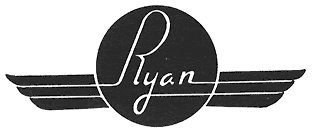 The first prototype
was fitted with a temporary landing gear and made its first horizontal
flight on 10 December 1955. It later made full conversions to vertical
attitude and back at altitude. The landing gear was then replaced
by a rear mounted castoring framework, known as the "roller-skate"
and hooking practice was conducted.
The first prototype
was fitted with a temporary landing gear and made its first horizontal
flight on 10 December 1955. It later made full conversions to vertical
attitude and back at altitude. The landing gear was then replaced
by a rear mounted castoring framework, known as the "roller-skate"
and hooking practice was conducted.
The second prototype followed a similar progression; on 11 April 1957, it made a vertical take-off from the raised trailer, transitioned to horizontal flight and back, ending with hooking on the wire "trapeze." On 28-29 July of that year, the X-13 was demonstrated in Washington, hovering across the river to the Pentagon. The Air Force chose not to continue development of the Vertijet because of the lack of an operational requirement.
Throughout the 1950s, most major aircraft manufacturers in the United States were anticipating the application of Vertical Takeoff and Landing (VTOL) technology to many types of military aircraft. The armed forces expended considerable sums to develop VTOL aircraft that could remain safely dispersed at small operating sites without the need for cumbersome and vulnerable airbases or aircraft carriers in an age of intercontinental ballistic missiles and thermonuclear weapons. An aircraft with a thrust-to-weight ratio greater than one could launch vertically, and once airborne, transition to horizontal flight for completion of its mission, and return for a vertical landing without expensive, easily targeted runways. The Ryan Aircraft Corporation attempted to convert this idea into a practical fighter for the Air Force with its X-13 Vertijet. However, like most other VTOL aircraft, the performance compromises made for their unique capabilities did not warrant its introduction in place of more capable conventional aircraft.
The idea for the Vertijet originated just after World War Two when engineers for Ryan casually debated whether or not their FR-1 Fireball, which had a thrust-to-weight ratio of one at low fuel quantities, could take off vertically. The vertical take-off idea soon advanced beyond the discussion stage.
In 1947, the Navy's Bureau of Aeronautics
awarded Ryan a contract to investigate the technical challenges involved
in the development of a vertically-launched jet fighter as part of
a program to evaluate the feasibility of submarine-based aircraft.
The Navy also funded a series of "tail-sitter" aircraft
that centered on conventionally-configured airplanes, equipped with
large counter-rotating propellers that would rest vertically on a
strengthened tail section. These designs, which included the Convair
XFY-1 and Lockheed XFV-1, were to use their high-thrust propellers
to rise vertically from a broad range of naval vessels, thus allowing
defensive air cov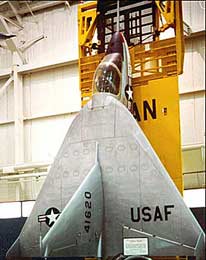 er without aircraft carriers.
er without aircraft carriers.
Ryan's engineering studies revealed that a similar jet-powered design was feasible with a reaction control system that diverted exhaust gasses in the appropriate direction to allow control during hovering and low-speed flight. A subsequent Navy contract funded construction of an unmanned flying demonstrator, which first flew on October 20, 1950. This ungainly contraption, powered by an Allison J33 turbine, and known affectionately as the "beast in the back yard," used a ball mounted nozzle to provide reaction control while hovering. Ryan engineers converted a B-47 fuel tank into a cockpit to allow test pilot Peter Girard to evaluate the test-bed's suitability as a manned research aircraft, which sat on its tail to take off vertically. On November 24, 1953, Girard made the first manned hovering flight in a jet aircraft with this unusual machine.
After Navy funding ran out, the Air Force became interested in Ryan's experiments and in July 1954 issued a contract to the company to construct two VTOL tail-sitter demonstrators, designated as the X-13 Vertijet. This project, based on the earlier Navy design proposal, was to demonstrate the suitability of easily dispersible VTOL fighters. The X-13, designed and built under the direction of Chief Engineer Curtiss Bates, emerged as a compact, single-engine delta-wing fighter. The only unusual feature visible to the casual observer was a set of winglets and the fixed landing gear. The Ryan Technical Section, led by Robert Fuhrman, designed the aircraft to travel on a special trailer, which would tilt vertically for the launch and recovery of the X-13 during vertical takeoffs and landings.
By late 1955, Ryan completed the first Vertijet (s/n 54-1619), and on December 10, Girard took off for its maiden flight. For its initial testing, the X-13 sported a fixed tricycle landing gear and flew as a conventional airplane. Fuhrman and his team did not want to risk vertical flight-testing until they had thoroughly explored the conventional handling characteristics of the X-13. After the installation of dampers had solved oscillation problems revealed during this phase of the testing, engineers added a temporary steel-tube truss with castering wheels to the rear of the X-13. This allowed the aircraft to sit on its tail during the vertical flight-testing phase without the need for the complex launch and recovery procedures inherent to the launch trailer. Pete Girard made the first vertical takeoff and landing on May 28, 1956. On the same day, the second X-13 made its first flight. The aircraft was agile and responsive in conventional flight.
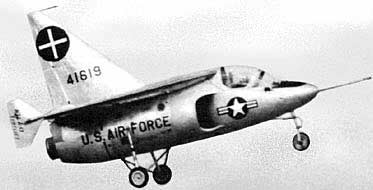 In conventional flight, elevons and a rudder controlled the X-13. As
the aircraft transitioned to a nose-high attitude to "hover"
on the thrust from its own engine, a vectorable exhaust nozzle linked
to the controls provided a simple and effective means of control. Small
bleed-air thrusters mounted on the wingtips allowed for the small adjustments
to the pitch and yaw of the aircraft when required by the tricky landing
process. A stability augmentation system integrated the conventional
and VTOL control systems together without requiring any abrupt changes
to pilot control inputs. The vertical takeoff
procedure consisted of elevating the bed of the launch trailer vertically,
which allowed the X-13 to hang from a cable suspended by two arms on
the top of the trailer, with a partially retractable hook.
In conventional flight, elevons and a rudder controlled the X-13. As
the aircraft transitioned to a nose-high attitude to "hover"
on the thrust from its own engine, a vectorable exhaust nozzle linked
to the controls provided a simple and effective means of control. Small
bleed-air thrusters mounted on the wingtips allowed for the small adjustments
to the pitch and yaw of the aircraft when required by the tricky landing
process. A stability augmentation system integrated the conventional
and VTOL control systems together without requiring any abrupt changes
to pilot control inputs. The vertical takeoff
procedure consisted of elevating the bed of the launch trailer vertically,
which allowed the X-13 to hang from a cable suspended by two arms on
the top of the trailer, with a partially retractable hook.
For vertical operations, a flat bumper replaced each of the main wheels on the fixed landing gear, which kept the underside of the fuselage from damage if it swung into the bed of the trailer, which made transport easier. The pilot then simply increased throttle until the hook lifted off the launch cable, backed away from the trailer and then accelerated vertically, smoothly pitching over to conventional flight, However, vertical landings were more difficult and were probably the most impractical part of the Vertijet concept. Its greatest flaw, as with the earlier tail-sitters, was the obscuration of the pilot's vision by the airframe, which made it extremely difficult to judge the distance to the ground adequately without outside assistance.
Although the pilot's seat pivoted 45 degrees towards vertical during landing, the pilot still had to approach the recovery trailer blind with the underside of the fuselage facing the surface of the trailer. Constant radio communication with a ground observer was essential to talk the X-13 into position during the cumbersome process. A 6 meter (20 foot) long folding pole with marked gradations attached to the top of the recovery trailer gave the pilot a clear indication of the distance remaining before he contacted the trailer. Once in position, the pilot slowly retarded the throttle until the nose hook caught the recovery cable.
On May 28, 1956, the X-13 ma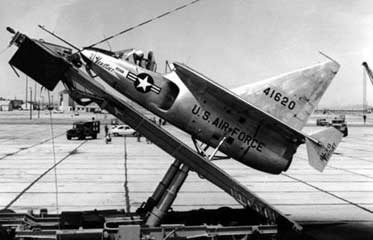 de
its first vertical hovering flight, and during that summer, Girard and
fellow test pilot, Lou Everett, began practicing the techniques required
to catch the cable on the launch-and-recovery trailer by hooking a one-inch
thick rope strung between two towers. For these tests, the Ryan engineers
fitted X-13 with a wooden nose that was easily replaceable if damage
occurred while the aircraft docked with the trailer.
de
its first vertical hovering flight, and during that summer, Girard and
fellow test pilot, Lou Everett, began practicing the techniques required
to catch the cable on the launch-and-recovery trailer by hooking a one-inch
thick rope strung between two towers. For these tests, the Ryan engineers
fitted X-13 with a wooden nose that was easily replaceable if damage
occurred while the aircraft docked with the trailer.
On November 28, Girard made the first transition from horizontal to vertical flight and back again in the X-13. On April 11, 1957, he launched from the trailer, transitioned to conventional flight, and returned for a vertical landing, thus completing the X-13's mission profile. On July 30, 1957, to illustrate the dispersed operating site concept the second X-13 put on an impressive display at the Pentagon for over 3,000 military officers and journalists.
However, competing programs reduced the funds available to continue the project, and the X-13 took to the air for the last time on September 30, 1957. While later programs, such as the XV-6 Kestrel (see NASM collection) and AV-8 Harrier, experienced greater success by resulting in operational aircraft, the X-13 was an effective solution to the problems of creating a VTOL fighter, given the limitations of jet technology at the time of its construction. The Vertijet accomplished all tasks specified for it and undoubtedly succeeded as an experimental demonstration aircraft, in spite of the inherent impracticality of the operational concept. Ironically, by the end of the twentieth century, the thrust vectoring system, initially pioneered on the X-13, would become an essential component of advanced combat aircraft. In 1960, Ryan donated the first X-13, along with its launch trailer, to the Smithsonian Institution.
Ryan X-13 Vertijet
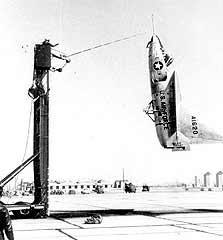 The experience of the two big tail sitting turbojets immediately raised
the question: was it possible to design a jet aircraft to take
off and land in the vertical mode? In theory, of course, there could
be no doubt; all that would be required would be a jet engine capable
of delivering more thrust to an aircraft than the combined weight
of airframe and engine--i.e., a favorable thrust-to-weight ratio.
The experience of the two big tail sitting turbojets immediately raised
the question: was it possible to design a jet aircraft to take
off and land in the vertical mode? In theory, of course, there could
be no doubt; all that would be required would be a jet engine capable
of delivering more thrust to an aircraft than the combined weight
of airframe and engine--i.e., a favorable thrust-to-weight ratio.
Commonplace today, this was not so easy to achieve in the mid-1950s. Until the present generation of high performance jet engines came along, delivering enormous thrust derived from high internal heat and pressures, aircraft depended upon light airframes, restricted payloads and superb streamlining in order to reach reasonable performance levels. With the modest engines then available, the only answer was to develop the smallest feasible airplane and, even then, to be content with moderate performance levels.
Based on the Ryan Aeronautical Company's successful combination jet-and-piston engine FR-1 Fireball fighter for the Navy, and impressed with the company's interest in developing higher thrust levels, the Air Force signed a contract for a pure-jet VTOL research aircraft on 28 July, 1954. The project expanded with the Navy and NACA joining as sponsors during various phases of the effort. The X-13 Vertijet which resulted was to be a proof-of-concept vehicle only and, in spite of overheated enthusiasm in some quarters, in no way was it ever a prototype fighter.
Minimalism was the key to the X-13's success. To begin with, it was tiny--24 ft long with a wingspan of only 21 ft, weighing a maximum of only 7,200 lbs--and numerous items found in conventional airplanes were omitted here: landing gear, flaps, dive brakes, no catapult or arresting gear, limited space for test instrumentation and absolutely none for armament. Fuel capacity was strictly limited, too, as one pilot found out to his discomfiture. During a demonstration flight from Andrews AFB to the Pentagon grounds in July, 1957, Peter Girard found that the plane carried barely enough fuel to do the job; a flubbed landing attempt would mean a prompt climb to altitude and ejecting. Nevertheless, he overcame Potomac boat traffic, blinding water spray and an unruly hedge in order to made history's first and only landing of a fixed-wing jet aircraft at the Pentagon.
For all its design limitations, the X-13 was a fully-functioning
airplane with operational controls, a simple delta-wing, tailless
design. Being jet-propelled, it had to deal with control problems
which its tail sitting turboprop cousins never faced. The XFV-1's heavy
prop blast washed over its wing and tail surfaces, mak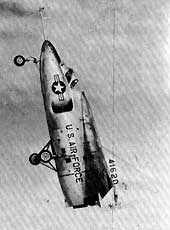 ing its rudder
and elevators effective at zero airspeed. Whenever the X-13 perched
atop its dynamic column of jet exhaust, however, its conventional
flight controls were useless. In order to be able to maneuver while
hovering, it used the first gimbaled nozzle ever mounted in an aircraft
to control pitch and yaw; wingtip nozzles provided roll control.
ing its rudder
and elevators effective at zero airspeed. Whenever the X-13 perched
atop its dynamic column of jet exhaust, however, its conventional
flight controls were useless. In order to be able to maneuver while
hovering, it used the first gimbaled nozzle ever mounted in an aircraft
to control pitch and yaw; wingtip nozzles provided roll control.
In place of landing gear, casters or a skid, the X-13 relied upon a simple hook mounted under its nose; instead of a launching pad or runway, it was mated to the flat bed of a truck. In preparation for a launch, the truck bed was hydraulically raised to a vertical position, like a dump truck, and the pilot would rotate his seat up to 45 degrees to compensate. At launch, the tiny jet would simply lift off vertically, rise to a few hundred feet, and arch over into horizontal flight, where its conventional controls would become effective. Its landing technique was equally simple and effective. Approaching the recovery trailer along a medium or low (usually low) profile, the pilot would point the aircraft's nose to the vertical, gradually slow to a zero airspeed a few feet above the ground, and then delicately "walk" his plane a few feet forward until the nose hook engaged a raised wire. With its engine cut, the X-13 would settle against the flatbed, ready to be lowered to the horizontal and trucked away.
The Vertijet was clearly a technical success. It proved its design concept and demonstrated that a VTOL flight with a jet aircraft was indeed possible. Practicality, however, was a different matter. The gallant little jet also proved to be a technological dead end; its feats were never replicated and no X-13 successors grace today's skies. Instead, aircraft designers took another and totally different approach to the problem of jet-propelled VTOL: directed thrust. Today's Harrier attack planes, widely used in several nations, take to the air on columns of vectored thrust, directed by gimbaled nozzles. However little a burly Marine Corps Harrier may resemble the elegant and delicate X-13, it nevertheless can claim the Vertijet in its design ancestry.
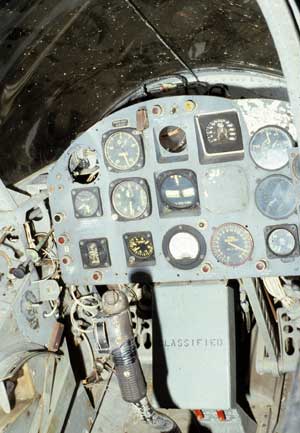 |
Cockpit of the Ryan X-13 Vertijet. |
Ryan X-13 Vertijet Specifications
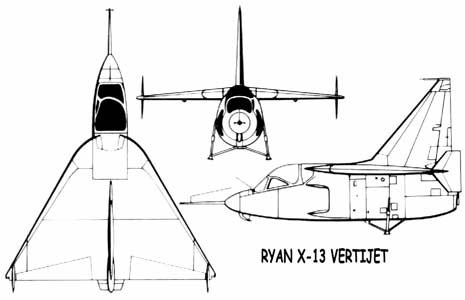 |
Length: 23 ft 5 in Wingspan: 21 ft Height: 15 ft 2 in Wing area: 191 ft² Empty weight: 5,334 lb Loaded weight: 6,730 lb Max takeoff weight: 7,200 lb Powerplant: 1× Rolls-Royce Avon turbojet, 10,000 lbf Performance Maximum speed: 350 mph Range: 192 miles Service ceiling: 20,000 ft Wing loading: 35.2 lb/ft² Thrust/weight: 1.48 |
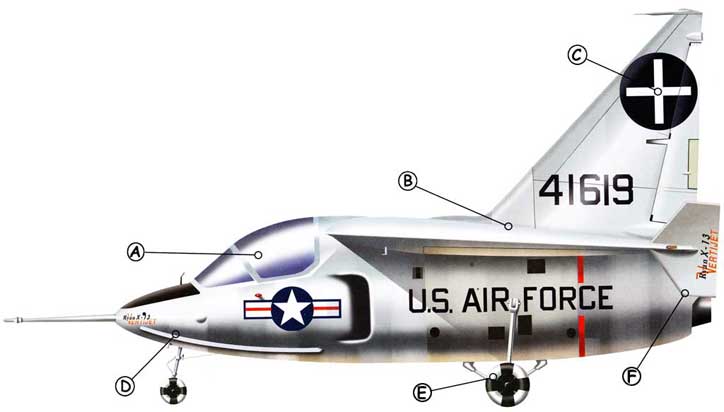 |
||
| A: A unique feature within the cockpit of the X-13 was a swiveling ejection seat. During early test flights the canopy was removed from the aircraft as a safety precaution for the pilot. | B: Ryan built only two X-13 Vertijets, Both survived the the extensive flight test program. Eventually, was retired to the USADF Museum in Ohio. | C: During every flight a cameraman was present to record the maneuvers of the X-13. To aid filming, large reference markings were painted onto the aircraft. |
| D: To allow the X-13 to attach itself to the vertical test rig, a large hook was positioned on the underside of the forward fuselage. This connected to a wire upon landing. | E: To allow pilots to explore the level flight characteristics of the X-13 a temporary tricycle undercarriage was fitted. After a short test period, this was removed. | F: To assist directional stability during vertical flight maneuvers, small winglets were attached to the outer wings. These greatly improved handling at low speeds and during the transition stage. |



